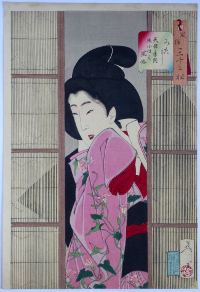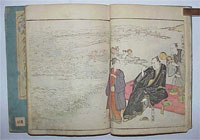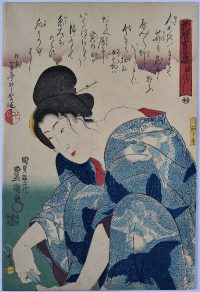/category/archive/page/45/
Tsukioka YOSHITOSHI (1839-1892)
Click here to view image full size.
Mita-so: Tempo nenkan o-kosho fuzoku, “Looking Inquisitive: The Appearance of a Maid in the Tempo Era” ( 1830 – 1844 ). From the set: Thirty-two Aspects of Women published by Tsunashima Kamekichi, 1888. Shows a maid peering through a summer bamboo screen.
Superb impression of the first edition. Very fine colour and condition with the extra paper at left edge and the full handling area showing bottom right. Beautiful blind-printing and a polished pattern applied to the black obi. Signed Yoshitoshi ga.
Status: Sold
Utagawa KUNIYOSHI (1797-1861)
Click here to view image full size.
Etchu Namerikawa otako, “Giant Octopuses in Namerikawa in Etchu” and sub-title Oo itai, “Ouch.” Obviously the cat’s claw being compared to the menacing tentacles of the octopus. A series of seventy prints Sankai medetai zue, “Affectionate Feelings for Mountains and Seas.” The set compares half-length beauties with famous products of the locality. Published by Tsurakichi, 1852. Kuniyoshi was particularly fond of cats and his studio was known to be home to a number of them. This may be his best evocation of a cat.
Superb impression with the cat’s coat blind-printed. Very fine colour and condition. Signed Ichiyusai Kuniyoshi ga.
Status: Sold
Utagawa TOYOKUNI I (1769-1825)

Click here to view image full size.
A beauty climbing stairs, the ninth month from a set of twelve. Published c 1813 by Nishimuraya Yohachi. Beauties ascending stairs was a stock subject for ukiyo-e artists. I’m not sure why.
Fine impression, colour and condition. Signed Toyokuni ga.
Status: Sold
Chobunsai EISHI (1756-1829)
Click here to view image full size.
An aiban from a set of four prints: Shiki warabe asobi, a series of prints comparing young children to the four seasons. Another from the set is illustrated in Estampes Japonaises. Collection des Musees royeaux d’Art et d’Histoire, Bruxelles, 1989, cat. 319, p. XXXIX ( incorrectly attributed to Eisho ). Published by Izumiya Ichibei 1795-6.
Very good impression, colour and condition. Full size. Signed Eishi.
Status: Sold
Utagawa TOYOKUNI I (1769-1825)

Click here to view image full size.
A beauty from a set Furyu hakkei, “Fashionable Eight Views.” Each beauty represents one of the famous Eight Views of Omi, here being Evening Glow at Seta.This theme, which originates from China, is often encountered in Japanese art. Shows a young woman unrolling a scroll with a view (presumably) of Seta Bridge. An extremely rare set with the designs standing alone but also forming diptychs. Three other single prints from the set are illustrated in Ukiyoe-e Taikei, vol. 9, no. 6, Night Rain, in colour, and nos. 101, Evening Snow and 102, Returning Sail, in b/w. A complete (faded) diptych is in the MFA Boston, Returning Sail and Returning Geese, 21.7473-4. I cannot, at the moment, locate another impression of this design. Published by Izumiya Ichibei (Kansendo) c 1794 – Toyokuni’s best period. Provenance: Ex collection Hayashi (seal bottom left) and Louis Gonse. A beautiful print.
Fine impression. Slight loss of gold in cloud at top but otherwise fine colour. Fine condition. Signed Toyokuni ga.
Status: Sold
Kitagawa UTAMARO (1753-1806)

Click here to view image full size.
Shows Shinanoya Ohan (left) and Obiya Choemon from a series of half-length portraits of pairs of lovers featured in joruri love-suicide plays. Jisu kurabe iro no minakami, “True Feelings Compared: The Founts of Love.” Choemon was the adopted heir of Obiya, an obi business in Kyoto. Ohan was a young girl from the Shinanoya store next door. In fact, the drama is based on an actual event in Kyoto during the Kyoho era. Two dead bodies were discovered in the Katsuragawa; one of a 50 year old man, the other of a 14 or 15 year old girl. Published by Nishimuraya “Sei” c 1798-9. Another impression is in the MFA Boston, 11.14296. Provenance: Ex Louis Gonse collection. Rare.
Fine impression. Exceptionally good colour. Fine condition. Signed Utamaro hitsu.
Status: Sold
Chobunsai EISHI (1756-1829)

Click here to view image full size.
A parading oiran, Senzan of the Choji-ya, with her two kamuro Isoji and Hanaji. From a set Seiro moyo awase “Comparisons of Brothel Patterns.” Published by Nishimuraya Yohachi (Eijudo), c 1796-7. See Brandt, Hosoda Eishi, Eike Moog, 1977, 100. No. 263. Provenance: Ex Louis Gonse collection.
Fine impression. Exceptional colour. Fine condition.
Status: Sold
Kitagawa UTAMARO II (?-1831?)

Click here to view image full size.
A mother holding her child dressed as Kintaro (later Sakata no Kintoki) holding a small hatchet (ono). From a series Shichi henge kodakara asobi, “Dance of Seven Changes Played by Precious Children.” Published by Iwatoya Kisaburo, 1812.
Fine impression. Very good colour. Very minor soil, otherwise very good condition. Signed Utamaro hitsu.
Status: Sold
Tsukioka YOSHITOSHI (1839-1892)

Click here to view image full size.
Tanoshindei-so: Kaei nenken shisho no fuzoku, “Looking as if She is Enjoying Herself: The Appearance of a Teacher During the Kaei Period [1848-1854].” Shows a samisen teacher, the majority of whose pupils would have been geisha. From a set Thirty-two Aspects of Women published by Tsunashima Kamekichi, 1888. The set depicts women of different backgrounds and occupations from the Kansei era through to the Meiji era with punning allusions to their situation or mood.
Very fine impression of the true first edition. Fine colour and condition. Signed Yoshitoshi ga.
Status: Sold
Isoda KORYUSAI (1735-1790)

Click here to view image full size.
An hashira-e, “pillar print.” A night scene showing a beauty on the shoulders of her lover reaching up to a branch of plum blossom beneath a spring moon. From a set Furyu Rokkasen, “Fashionable Six Poetic Immortals,” this being a poem by Ariwara no Narihira (825-880) where the poet composes a poem inspired by a beauty he has seen. Koryusai was the master of this format. Pillar prints were introduced to hang, when mounted, on the pillars of a Japanese house. Consequently, they often come browned, creased or faded and finding good examples is difficult. Rare: Not in Pins.
Very good impression and colour. Slightly toned, otherwise very good condition. Signed Koryusai ga.
Status: Sold
Kitagawa UTAMARO (1753-1806)
Click here to view image full size.
A benigirai-e (red-avoiding) triptych showing from right to left: A young nobleman with a falcon, a beauty beside him holding his sword and another seated smoking a pipe; the centre panel shows two women and a child holding a small falcon; while the last sheet has two women selecting eggplants from the baskets of an eggplant seller. The backdrop for the whole scene is a majestic Mt. Fuji. The combination of Fuji, falcon and eggplant is known as Ichi-Fuji, Ni-Taka, San-Nasubi (1-Fuji, 2-Falcon, 3-Eggplant) and it is supposed to be good luck to dream of these three in the first dream of the New Year (or, in fact, on the second night, the first being sleepless. The following day is known as hatsuyume). Extremely rare: the only impression I can find is illustrated in Kiyoshi Shibui, Ukiyoe zuten, No. 13, Utamaro, p. 37. (The date given here is 1801, although the late 1790s might be more appropriate as the vogue for benigirai-e [probably as a response to sumptuary edicts] was prevalent around the 1790s.) Published by Murataya Jirobei of Eiyudo. Another triptych by Utamaro of this subject is illustrated in Yoshida, Utamaro zenshu, p. 156. A very fine design.
Fine impression. Extremely good colour: these pigments are very susceptible to any light or moisture. Extremely good condition.Signed Utamaro hitsu.
Status: Sold
Hosoda EISHI (1756-1829)
Click here to view image full size.
A triptych representing Matsukaze, “The Wind in the Pines,” Chapter XVIII, from a set of triptychs Furyu yatsushi Genji, “Genji in Modern Dress.” Brandt, Hosoda Eishi, Stuttgart, 1977, lists nine from the series (this being no. 58, p. 116, illustrated p. 16). Based on the famous early 11th century novel Genji Monogatari written by Murasaki Shikibu. Shows court ladies, one playing a koto on the engawa far right, others welcoming the arrival of Prince Genji, far left. Published by Senichi, c. 1792. Provenance: Ex Worcester Art Museum and Louis W. Black collections, sold Sothebys N.Y., 4/3/1976, lot 122.
Extremely fine impression and perfect unfaded colours. Album backing, otherwise fine condition. Signed Eishi ga (with a small sumi insertion to read Eisui).
Status: Sold
Utagawa TOYOKUNI I (1769-1825)
Click here to view image full size.
Two volumes complete Yakusha sangaikyo, “Amusements of Actors on the Third Floor” (iez the dressing-rooms or green rooms). Published Kansei 13 (1801) by Nishimiya Shinroku and Yorozuya Tajiemon, Edo. An extremely rare and important work showing actors engaged in various private pursuits and not on stage, as is normal. Original covers and title slips. Ex Duret and Gillot collections.
Slight turning of some colours on vol two and some slight thumbing on bottom corners of some sheets, but overall very good and an essential item for any serious collection.
Status: Sold
Utgawa HIROSHIGE (1797-1858)

Click here to view image full size.
A beauty from a set: Edo meisho gosho, “Five Elements of Famous Places in Edo.” This design representing Water of Kameido, Kameido no mizu, and Metal of Ueno, Uenoji no kane. A rare set published by Kikakudo, c. 1847-52.
Very fine impression, colour and condition. Signed Hiroshige ga.
Status: Sold
Tsukioka YOSHITOSHI (1839-1892)

Click here to view image full size.
Urusa-so: Kansei nenkan shojo no fuzoku, “Looking Tiresome: The Appearance of a Virgin of the Kansei Era [1789-1801]” Shows a young woman playing with her cat from a set Thirty-two Aspects of Women published by Tsunashima Kamekichi, 1888. The set shows women of different backgrounds and occupations from the Kansei era through to the Meiji era with punning allusions to their situation or mood. One of the three best designs from the set.
Very fine impression of the first edition with blind printing on the cat. Fine colour and condition with the extra border left and top. Signed Yoshitoshi ga.
Status: Sold
Tsukioka YOSHITOSHI (1839-1892)

Click here to view image full size.
Kayu-so: Kaei nenken kakoi-mono no fuzoku, “Looking Itchy: The Appearance of a Kept Woman of the Kaei era [1848-1854]. Shows a bare-breasted beauty emerging from a mosquito net from a set Thirty-two Aspects of Women published by Tsunashima Kamekichi, 1888. The set shows women of different backgrounds and occupations from the Kansei era through to the Meiji era with punning allusions to their situation or mood. One of the three best designs from the set.
Very fine impression of the first edition. Fine colour and condition with the extra border left and top. Signed Yoshitoshi ga.
Status: Sold
Isoda KORYUSAI (1735-1790)

Click here to view image full size.
An oiran, Meizan (or Nayama) of the Chojiya House in the Shin-Yoshiwara with her two kamuro. From a large series – the total not known – with title: Hinagata wakana no hatsu moyo, “New Designs as Fresh as Young Leaves.” Published in the late 1770s by Eijudo with some designs by Juzaburo. A wonderful set. Another impression in MFA, 11.14622.
Fine impression. Exceptionally good colour. Very slight thinning down two sides, otherwise fine condition. Signed Koryu ga with printed kakihan.
Status: Sold
Utagawa KUNIYOSHI (1797-1861)

Click here to view image full size.
A triptych: Mitate gogyo: Mizu, Ukifune, “Comparisons of the Five Elements: Water,” Ukifune. Shows Prince Genji in a boat with his attendants feeding ducks during the winter. Ukifune was the nickname of a princess in The Tale of Genji. An unrecognised daughter of the Eighth Prince in the 51st Chapter of the story. Ukifune also means: “A boat set adrift.” Published by Sanoki (Sanoya Kihei), 1851-52.
Superb impression, colour and condition. Signed Ichiyusai
Status: Sold
Torii KIYONAGA (1752-1815)

Click here to view image full size.
A chuban print showing a woman at a washtub watched by a small child. Another woman is hanging a kimono out to dry. Without any series title but with a scalloped cloud above which may have been intended to have a title. Published c. late 1770s. Rare: Not listed in Hirano, Chie Hirano, Kiyonaga, MFAB, 1939.
Superb impression, colour and condition. Possibly a proof impression. Signed Kiyonaga ga.
Status: Sold
Isoda KORYUSAI (1735-1790)
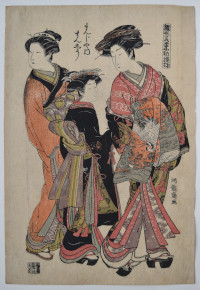
Click here to view image full size.
Manjiya uchi Manshiu, “Manshiu of the Manjiya [Brothel or House]” from a set: Hinagata wakana no hatsu moyo, “New Year Designs as Fresh as Young Leaves.” One of the great 18th century sets comprising at least 140 prints of consistent quality throughout. Shows the oiran with her two kamuro. Published in the late 1770s by Eijudo with some designs by Juzaburo.
Fine impression and colour. Slight creasing, otherwise very good condition. On heavy hosho. Signed Koryusai ga.
Status: Sold
Kitao SHIGEMASA (1739-1820)
Click here to view image full size.
Kanzashi no seiran, “Clearing Weather of the Hairpin” from a chuban set Jochu tedogu hakkei, “Eight Views of Women’s Utensils.” Published c. 1777. Another from the set published in the Clarence Buckingham Collection of Japanese Prints, Margaret O. Gentles, vol. II, The Art Institute of Chicago, 1965, no. 21, p. 283.
Very good impression, colour and condition. Unsigned.
Status: Sold
Hosoda EISHI (1756-1829)
Click here to view image full size.
A small chuban print showing silkworm cultivation. Two girls feed mulberry leaves to the silkworms, another stands behind. A certain license was taken with this subject and designs did not necessarily faithfully follow the procedure or the girls truly depict the actual labourers. Published by Nishimuraya Yohachi, c 1800. This set (probably of 12) would have been printed two-to-a-sheet. Rare.
Fine impression and fine unfaded colours. Fine condition. Signed Eishi ga.
Status: Sold
Utagawa KUNIYOSHI (1797-1861)
Click here to view image full size.
The poetess Ome Shushiki (1668-1725) looking at a poem attached to a tree at Ueno. A chu-tanzaku set of eight prints: Kenjo hakkei, “Eight Views of Accomplished Women.” The set published by Ibaya Sensaburo, c 1843-5. Based on the famous Chinese Eight Views, Japanese artists designed many sets using the Eight Views of Omi as their starting point. Here, Vesper Bell at Ueno [Miidera].
Very good impression and colour. Minor trimming (usual, as they were printed two-to-a-sheet), otherwise very good condition. Signed Ichiyusai Kuniyoshi ga.
Status: Sold
Utagawa KUNIYOSHI (1797-1861)
Click here to view image full size.
Kogo no Tsubone (1157 – ?) on a balcony after being banished from court. A chu-tanzaku set of eight prints: Kenjo hakkei, “Eight Views of Accomplished Women.” The set published by Ibaya Sensaburo, c 1843-5. Based on the famous Chinese Eight Views, Japanese artists designed many sets taking the Eight Views of Omi as their starting point. Here, Autumn Moon over Saga Moor [Ishiyama].
Very good impression and colour. Minor trimming (usual, as they were printed two-to-a-sheet), otherwise very good condition. Signed Ichiyusai Kuniyoshi ga.
Status: Sold
Utagawa KUNIYOSHI (1797-1861)
Click here to view image full size.
The faithful wife of Mama walking on a hillside with falling maple leaves. A chu-tanzaku set of eight prints: Kenjo hakkei, “Eight Views of Accomplished Women.” The set published by Ibaya Sensaburo, c 1843-5. Based on the famous Chinese Eight Views, Japanese artists designed many sets using the Eight Views of Omi as their starting point. Here, Clearing Weather at Mama [Awazu].
Very good impression and colour. Minor trimming (usual, as they were printed two-to-a-sheet), otherwise very good condition. Signed Cho-o-ro Kuniyoshi ga.
Status: Sold
Attributed to KATSUNO (Fl. c 1807)
Click here to view image full size.
A hosoban kappazuri (stencil) print of the beauty Kuruharu (or Yukiharu) of the Naraya brothel/tea house holding a teacup. Published by Kashiwaya Soshichi, a Kyoto publisher in c 1807. He is known to have produced prints for Nagahide as well. The artist Katsuno is only known by a few stencil prints around this date; some, as here, unsigned, and it may well be the only impression extant.
Good impression (they are never fine), very good colour and condition. Unsigned.
Status: Sold
Utagawa KUNISADA (1786-1864)
Click here to view image full size.
A triptych showing a party of women and a child running in rain towards the entrance of the Mimeguri Shrine. Mimeguri no yudachi, “An Evening Shower at Mimeguri.” This famous shrine was on the bank of the Sumida at Mukojima and a short ferry ride from Asakusa. The shrine is also associated with prayers for rain. Kunisada was the most prolific 19th century artist, but amongst his vast output are real masterpieces. Published c 1830. A fine design.
Fine impression, colour and condition. Signed Kochoro Kunisada ga.
Status: Sold
Kochoro KUNISADA (1786-1864)
Click here to view image full size.
Shows a trainee courtesan applying rouge to her eyes. Odori shisho, “The Dancing Girl” from a set Tosei bijin awase, “A Collection of Modern Beauties.” The set published by Moritaya Hanzo, c. 1826. Above, in the fan-shaped label are the accoutrements of her trade: a wig stand, a pair of clappers to keep time, and the libretto of a song.
Fine impression. Very good colour and condition. Signed Kochoro Kunisada ga.
Status: Sold
Suzuki HARUNOBU (1724-1770)

Click here to view image full size.
The left sheet of a rare diptych which was originally produced as an egoyomi (picture calendar) in 1766. A mitate (parody) of Chapter 4, Yugao, from the Genji Monogatari, “Tale of Genji.” This chapter relates how a mysterious beauty living in a mansion covered in vines with flowering yugao blossom (shown here covering the fence) enraptures Genji and they consummate their passion in a remote villa. However, one of Genji’s former lovers discovers the tryst and takes the life of “Yugao.” The right sheet shows a fashionably dressed young wakashu and a boy holding a miniature ox cart cricket cage. Other impressions in: Margaret O. Gentles, The Clarence Buckingham Collection, volume II, AIC, 1965, p. 26, no. 44; Tokyo National Museum, acc. no. A-10569_1274 (diptych) (inv. No. 10-5006); David Waterhouse, The Harunobu Decade, Museum of Fine Arts, Boston, 2013, vol. 1, pp. 88-89, cat. No. 100, acc. nos. 54.348-9 (diptych) and 21.4969 (left sheet); and Ukiyo-e Shuka, vol. 8, 1980, listed p. 116, no. 114. Rare.
Fine impression with the woodgrain showing strongly in the background as though it were blind-printed. Very good colour and condition.
Status: Sold
Chokosai EISHO (Active 1780-1800)

Click here to view image full size.
The courtesans Hinazuru, Origiku and Misayama of the Chojiya House. The most prolific of Eishi’s pupils who produced some outstanding bust portraits. Published by Yamaguchiya Chusuke, c late 1790’s. Another impression is in the Chazen Museum of Art, Madison, acc. no. 1984.215.
Very good impression and colour. There is a variant impression with different colours. Slight soil, otherwise good condition. Signed Eisho ga.
Status: Sold
Shosai GINKO (FL. 1874-1897)
Click here to view image full size.
A charming print showing a Japanese lady elegantly attired, western-style, standing beside a river with steamboats and foreign buildings in the background. She wears a full length coat, lace-trimmed, with colour-coordinated brolly, belt, cuffs and bow at the neck. On her head a stylish bonnet tied below the chin. From a set: Kokin meifu kagami, “A Mirror of Famous Women in Old and Modern Times.” This design shows Kosome, the daughter of Kuniya Sohei. During a boat trip around Japan in 1859 her vessel was hit by a storm and drifted until eventually arriving in Hawaii. Rescued by an American, she went on to study and become a teacher in America. The view behind her shown here obviously represents America.
Fine impression and colour with mica on the water. Light album backing and slight offsetting at top, otherwise good condition. Signed Shosai Ginko.
Status: Sold
Kochoro KUNISADA (1786-1865)
Click here to view image full size.
Tumekiri yoshi, “A Good Day to Trim One’s Nails” from Hanagoyami kichijitsu sugata “Beauties on Auspicious Days of the Flower Calendar.” A beauty in a bathrobe with scissors about to trim her toenails. The scissors have a small bell which is usually seen around the necks of cats. Published 1844.
Fine impression and colour. Superb cutting and printing of the aizuri design on the bathrobe. Very slight trimming. Retains original album backing. Signed Kunisada aratame nidaime Toyokuni ga, “Kunisada changing his name to the second of the name Toyokuni drew.”
Status: Sold
Kochoro KUNISADA (1786-1865)
Click here to view image full size.
The colour white from Ukiyo goshoku awase, “Matching with Five Colours of the Floating World.” A beauty before a mirror holding another mirror behind her to enable her to apply white make-up to the nape of her neck. A highly erogenous area to the Japanese. Published by Sanoya Kihei, 1845.
Very good impression and colour. Slight trimming and retains original album backing. Signed Kunisada aratame nidaime Toyokuni ga, “Kunisada changing his name to the second of the name Toyokuni drew.”
Status: Sold
Tsukioka YOSHITOSHI (1839-1892)

Click here to view image full size.
Megasame-so: Koka nenkan musume no fuzoku, “Looking as if She is Waking Up: The Appearance of a Maiden of the Koka Era [1844-1848].” Shows a beauty cleaning her teeth from a set Thirty-two Aspects of Women published by Tsunashima Kamekichi, 1888. The set depicts women of different backgrounds and occupations from the Kansei era through to the Meiji era with punning allusions to their situation or mood.
Very fine impression of the true first edition. Fine colour and condition. Signed Yoshitoshi ga.
ga.
Status: Sold
Kitagawa UTAMARO (1753-1806)
Click here to view image full size.
A beautiful aiban showing Fuku and Kame from a series Seiro Niwaka, “The Niwaka Festival in the Yoshiwara.” Sub-title Tsuki no Katsurao (Katsura Otoko). The “pleasure district” of Edo hosted the Niwaka Festival in the eighth month of each year where courtesans performed dances and there were entertainers. Published by Tsuruya Kiemon, c 1794-5. Rare: Apparently not listed in the standard Utamaro books.
Fine impression. Very well retained colour, the fugitive blue on the umbrella intact. Small repaired wormhole, otherwise very good condition. Full size. Signed Utamaro fude.
Status: Sold
Isoda KORYUSAI (1735-1790)

Click here to view image full size.
A hashira-e, “pillar print” showing two women washing clothes at a well. Koryusai cleverly uses the ropes of the pulley to emphasize the narrow format. Koryusai was the master of this sort of print. Pillar prints were introduced to hang, when mounted, on the pillars of a Japanese house. Consequently, they often come browned, creased or faded and finding good examples is difficult. Rare: Other examples in MFA Boston, acc. no. 21.8379 (ex Metzgar sale 1/12/1921); TNM, catalogue 1, (1960), no. 742; and illustrated in Pins, The Japanese Pillar Print, 1982, no. 396.
Very good impression. Good colour. Slight toning and small repair bottom right corner, but otherwise a nice example. Signed Koryusai ga.
Status: Sold
Keisai Eisen (1790-1848)
Click here to view image full size.
Yoshiwara from the set: “Bijin Tokaido” comparing beauties to the 53 Stations. Published by Tsutaya c 1830’s. A fine design.
Very fine impression, colour and, apart from minor trimming, fine condition. Signed Keisai Eisen ga
Status: Sold
Tsukioka YOSHITOSHI (1839-1892)

Click here to view image full size.
Niai-so: Koka nenkan kuruwa no geisha fuzoku, “Looking Suitable: The Appearance of a Brothel Geisha of the Koka Era [1844-1848].” From the set Thirty-two Aspects of Women published by Tsunashima Kamekichi, 1888. Shows the beauty dressed as a fashionable young man.
Very fine impression of the first edition. Very fine colour with blind-printing and burnishing. Gold (brass-powder) applied to the peacock design on the costume. This particular design from the set is notorious for having the brass degrade the paper and these areas fall out as well as offsetting onto the opposite print in album sets. Very fine condition. Signed Yoshitoshi ga.
Status: Sold
Tsukioka YOSHITOSHI (1839-1892)
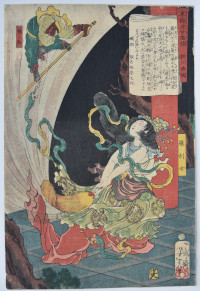
Click here to view image full size.
A design from the set Azuma nishiki ukiyo kodan, “Rough Tales of the Floating World.” Various publishers between 1867-1868, here Omi-Kyu in 1868. The prints interpret stories told by various well known storytellers, in this case Momokawa Enkoku. Shows the Monkey King (Son Goku) being catapulted into the air by the force of the large palm fan of Princess Iron Fan. (The fan was capable of creating strong winds and putting out fires.) She was a Rasetsunyo, a female protector of Buddhism. A comparatively rare set
Very good impression, colour and condition. Signed Ikkaisai Yoshitoshi hitsu.
Status: Sold
Utagawa TOYOKUNI I (1769-1825)

Click here to view image full size.
A fanciful version of the Yoshino River scene in Act III from the play Imoseyama onna teikin, “The Teachings for Women.” Two families own estates on opposite sides of the Yoshino River. The son of one, Koganosuke, falls in love with the daughter, Hinadori, of the other oblivious of the fact that the two families are bitter enemies. The couple rather commit suicide than be separated. In fact, the play was performed at the Kawarasaki-za Theatre, 7/1801, although this does not depict the actual performance. Interestingly, the publisher’s seal is omitted which is exactly the same as two other impressions in MFA, Boston, acc. no 21.7783-5 and the Salt and Tobacco Museum in Japan.
Very good impression. Extremely good colour. Very good condition. Signed Toyokuni ga.
Status: Sold
